Financial Performance Analysis: Wesfarmers and Coles, 2016-2017
VerifiedAdded on 2020/05/28
|9
|2141
|45
Report
AI Summary
This report provides a comprehensive financial analysis comparing the performance of Wesfarmers and its subsidiary, Coles, for the years 2016 and 2017. The analysis begins with an overview of Wesfarmers' financial results, including net profit, cash flow, and key financial ratios such as the current ratio, debt-equity ratio, profitability ratio, and return on assets. The report then delves into Coles' financial performance, examining revenue, earnings before interest and tax, total assets, liabilities, and return on assets, highlighting the impact of these figures on Wesfarmers' consolidated results. The analysis also considers the sustainability report of Wesfarmers, particularly focusing on the animal welfare policies adopted by Coles. The report assesses the company's initiatives regarding cage-free eggs and sow stall-free pork, alongside the five freedoms approach to animal welfare. Additionally, it provides a concise overview of the principles that guide the company's sustainable practices, concluding with references and bibliography.
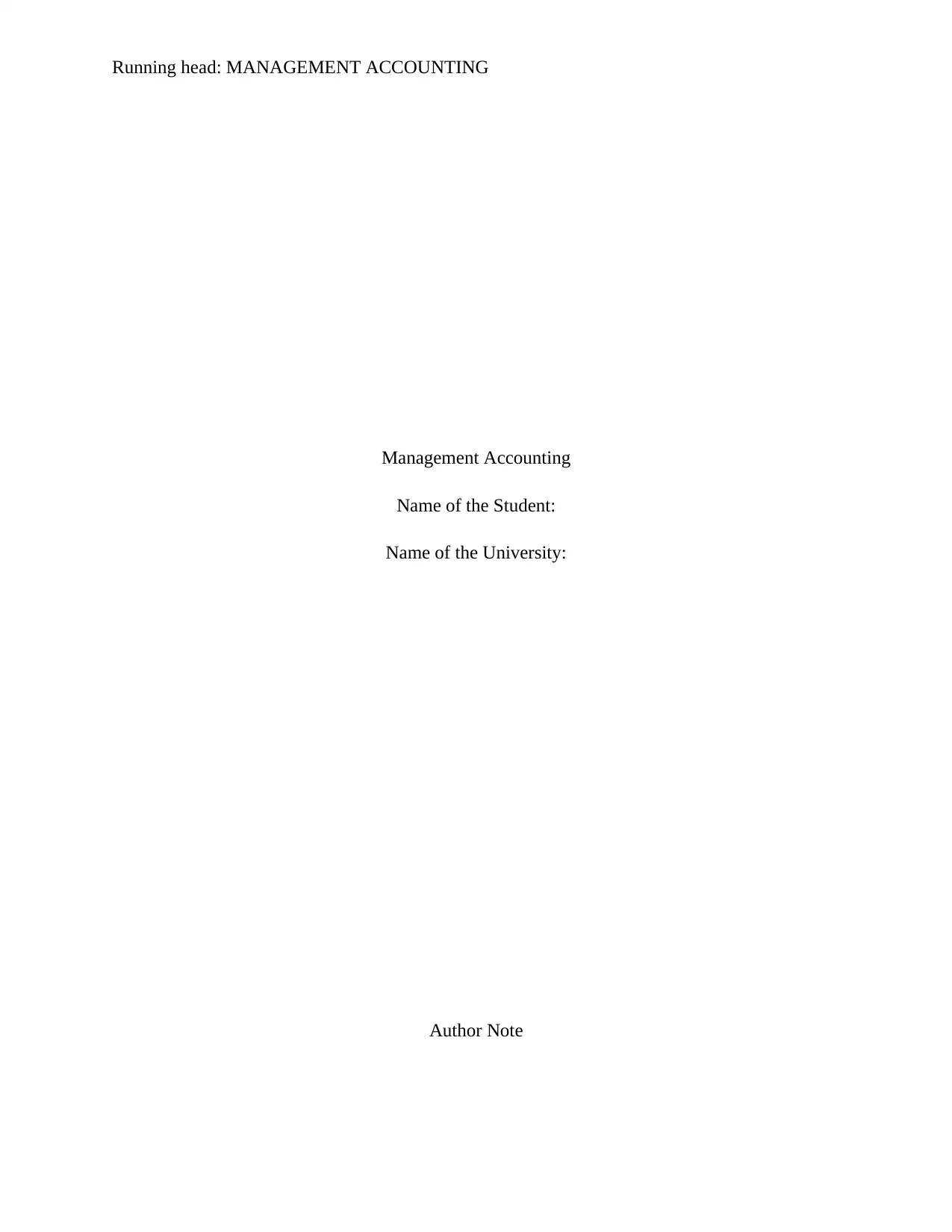
Running head: MANAGEMENT ACCOUNTING
Management Accounting
Name of the Student:
Name of the University:
Author Note
Management Accounting
Name of the Student:
Name of the University:
Author Note
Paraphrase This Document
Need a fresh take? Get an instant paraphrase of this document with our AI Paraphraser
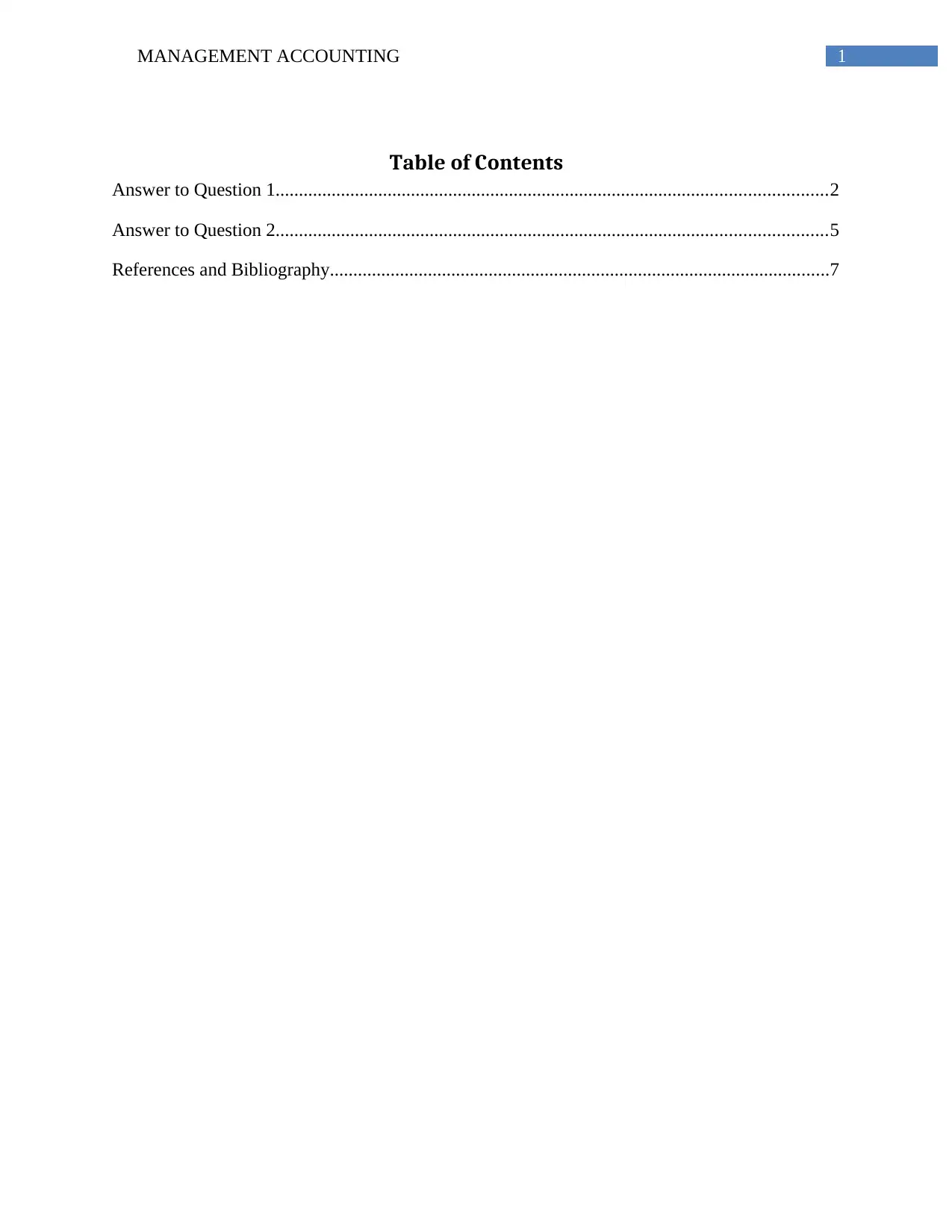
1MANAGEMENT ACCOUNTING
Table of Contents
Answer to Question 1......................................................................................................................2
Answer to Question 2......................................................................................................................5
References and Bibliography...........................................................................................................7
Table of Contents
Answer to Question 1......................................................................................................................2
Answer to Question 2......................................................................................................................5
References and Bibliography...........................................................................................................7
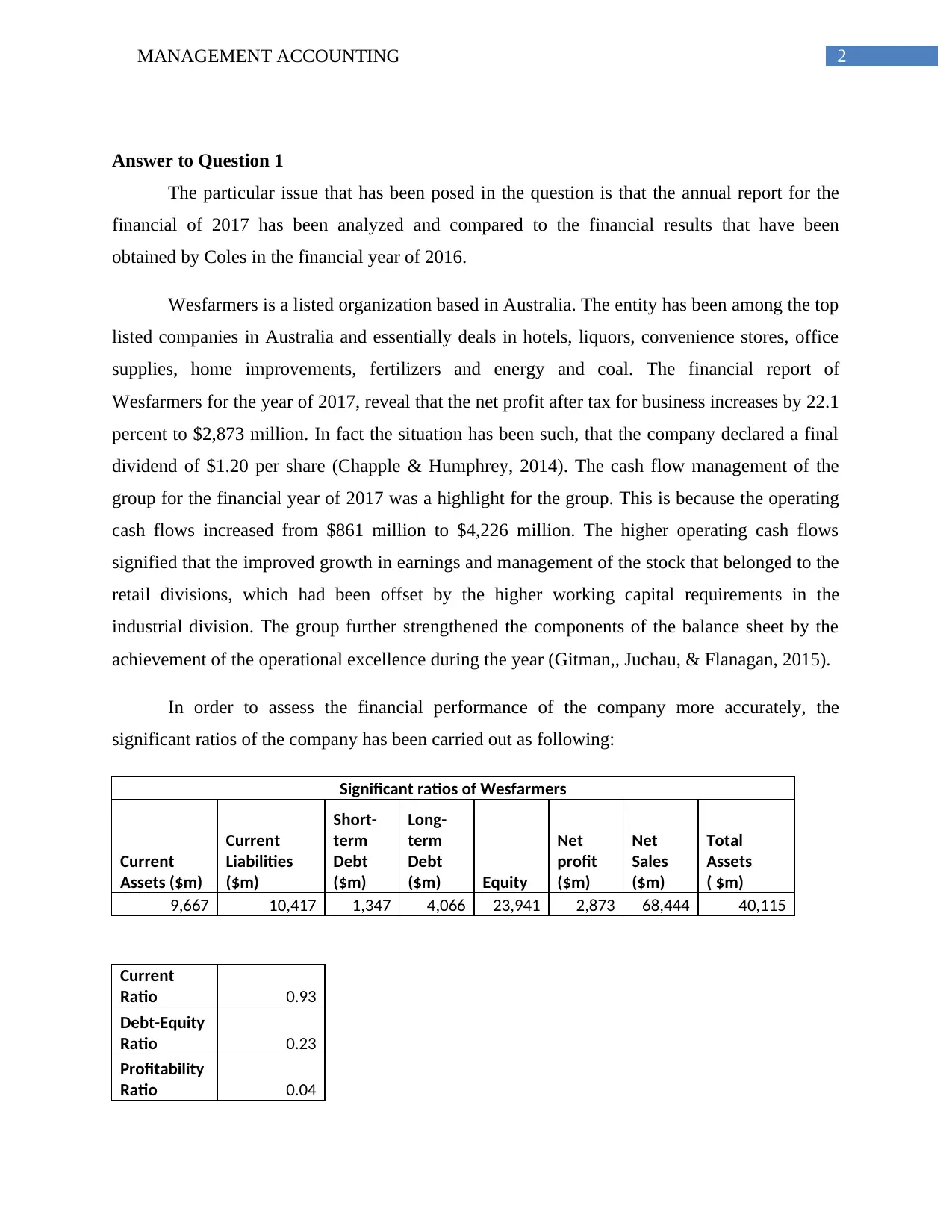
2MANAGEMENT ACCOUNTING
Answer to Question 1
The particular issue that has been posed in the question is that the annual report for the
financial of 2017 has been analyzed and compared to the financial results that have been
obtained by Coles in the financial year of 2016.
Wesfarmers is a listed organization based in Australia. The entity has been among the top
listed companies in Australia and essentially deals in hotels, liquors, convenience stores, office
supplies, home improvements, fertilizers and energy and coal. The financial report of
Wesfarmers for the year of 2017, reveal that the net profit after tax for business increases by 22.1
percent to $2,873 million. In fact the situation has been such, that the company declared a final
dividend of $1.20 per share (Chapple & Humphrey, 2014). The cash flow management of the
group for the financial year of 2017 was a highlight for the group. This is because the operating
cash flows increased from $861 million to $4,226 million. The higher operating cash flows
signified that the improved growth in earnings and management of the stock that belonged to the
retail divisions, which had been offset by the higher working capital requirements in the
industrial division. The group further strengthened the components of the balance sheet by the
achievement of the operational excellence during the year (Gitman,, Juchau, & Flanagan, 2015).
In order to assess the financial performance of the company more accurately, the
significant ratios of the company has been carried out as following:
Significant ratios of Wesfarmers
Current
Assets ($m)
Current
Liabilities
($m)
Short-
term
Debt
($m)
Long-
term
Debt
($m) Equity
Net
profit
($m)
Net
Sales
($m)
Total
Assets
( $m)
9,667 10,417 1,347 4,066 23,941 2,873 68,444 40,115
Current
Ratio 0.93
Debt-Equity
Ratio 0.23
Profitability
Ratio 0.04
Answer to Question 1
The particular issue that has been posed in the question is that the annual report for the
financial of 2017 has been analyzed and compared to the financial results that have been
obtained by Coles in the financial year of 2016.
Wesfarmers is a listed organization based in Australia. The entity has been among the top
listed companies in Australia and essentially deals in hotels, liquors, convenience stores, office
supplies, home improvements, fertilizers and energy and coal. The financial report of
Wesfarmers for the year of 2017, reveal that the net profit after tax for business increases by 22.1
percent to $2,873 million. In fact the situation has been such, that the company declared a final
dividend of $1.20 per share (Chapple & Humphrey, 2014). The cash flow management of the
group for the financial year of 2017 was a highlight for the group. This is because the operating
cash flows increased from $861 million to $4,226 million. The higher operating cash flows
signified that the improved growth in earnings and management of the stock that belonged to the
retail divisions, which had been offset by the higher working capital requirements in the
industrial division. The group further strengthened the components of the balance sheet by the
achievement of the operational excellence during the year (Gitman,, Juchau, & Flanagan, 2015).
In order to assess the financial performance of the company more accurately, the
significant ratios of the company has been carried out as following:
Significant ratios of Wesfarmers
Current
Assets ($m)
Current
Liabilities
($m)
Short-
term
Debt
($m)
Long-
term
Debt
($m) Equity
Net
profit
($m)
Net
Sales
($m)
Total
Assets
( $m)
9,667 10,417 1,347 4,066 23,941 2,873 68,444 40,115
Current
Ratio 0.93
Debt-Equity
Ratio 0.23
Profitability
Ratio 0.04
⊘ This is a preview!⊘
Do you want full access?
Subscribe today to unlock all pages.

Trusted by 1+ million students worldwide
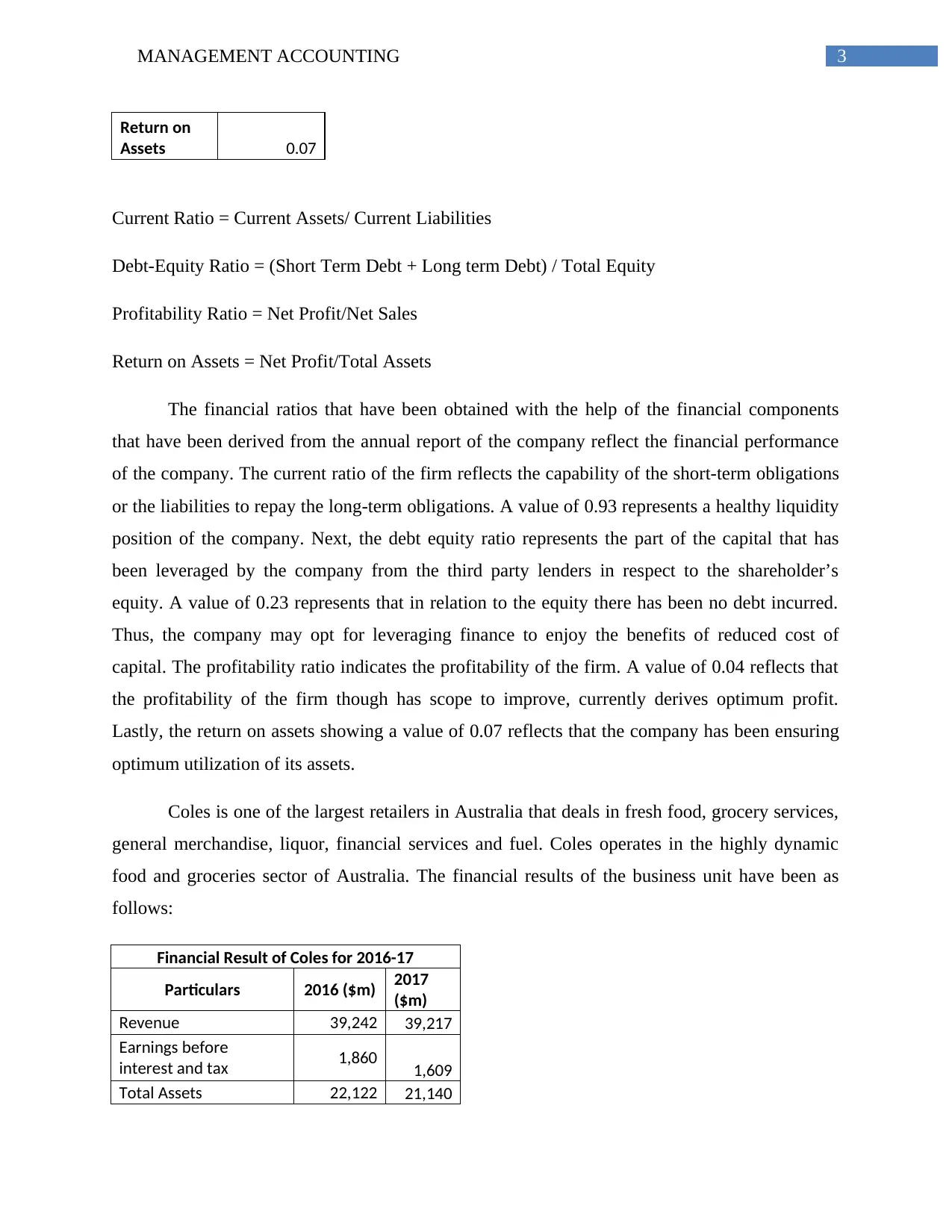
3MANAGEMENT ACCOUNTING
Return on
Assets 0.07
Current Ratio = Current Assets/ Current Liabilities
Debt-Equity Ratio = (Short Term Debt + Long term Debt) / Total Equity
Profitability Ratio = Net Profit/Net Sales
Return on Assets = Net Profit/Total Assets
The financial ratios that have been obtained with the help of the financial components
that have been derived from the annual report of the company reflect the financial performance
of the company. The current ratio of the firm reflects the capability of the short-term obligations
or the liabilities to repay the long-term obligations. A value of 0.93 represents a healthy liquidity
position of the company. Next, the debt equity ratio represents the part of the capital that has
been leveraged by the company from the third party lenders in respect to the shareholder’s
equity. A value of 0.23 represents that in relation to the equity there has been no debt incurred.
Thus, the company may opt for leveraging finance to enjoy the benefits of reduced cost of
capital. The profitability ratio indicates the profitability of the firm. A value of 0.04 reflects that
the profitability of the firm though has scope to improve, currently derives optimum profit.
Lastly, the return on assets showing a value of 0.07 reflects that the company has been ensuring
optimum utilization of its assets.
Coles is one of the largest retailers in Australia that deals in fresh food, grocery services,
general merchandise, liquor, financial services and fuel. Coles operates in the highly dynamic
food and groceries sector of Australia. The financial results of the business unit have been as
follows:
Financial Result of Coles for 2016-17
Particulars 2016 ($m) 2017
($m)
Revenue 39,242 39,217
Earnings before
interest and tax 1,860 1,609
Total Assets 22,122 21,140
Return on
Assets 0.07
Current Ratio = Current Assets/ Current Liabilities
Debt-Equity Ratio = (Short Term Debt + Long term Debt) / Total Equity
Profitability Ratio = Net Profit/Net Sales
Return on Assets = Net Profit/Total Assets
The financial ratios that have been obtained with the help of the financial components
that have been derived from the annual report of the company reflect the financial performance
of the company. The current ratio of the firm reflects the capability of the short-term obligations
or the liabilities to repay the long-term obligations. A value of 0.93 represents a healthy liquidity
position of the company. Next, the debt equity ratio represents the part of the capital that has
been leveraged by the company from the third party lenders in respect to the shareholder’s
equity. A value of 0.23 represents that in relation to the equity there has been no debt incurred.
Thus, the company may opt for leveraging finance to enjoy the benefits of reduced cost of
capital. The profitability ratio indicates the profitability of the firm. A value of 0.04 reflects that
the profitability of the firm though has scope to improve, currently derives optimum profit.
Lastly, the return on assets showing a value of 0.07 reflects that the company has been ensuring
optimum utilization of its assets.
Coles is one of the largest retailers in Australia that deals in fresh food, grocery services,
general merchandise, liquor, financial services and fuel. Coles operates in the highly dynamic
food and groceries sector of Australia. The financial results of the business unit have been as
follows:
Financial Result of Coles for 2016-17
Particulars 2016 ($m) 2017
($m)
Revenue 39,242 39,217
Earnings before
interest and tax 1,860 1,609
Total Assets 22,122 21,140
Paraphrase This Document
Need a fresh take? Get an instant paraphrase of this document with our AI Paraphraser

4MANAGEMENT ACCOUNTING
Total Liabilities 4,273 4,245
Capital employed 16,541 16,586
Return on Assets 11.20 10
The financial results of the unit as can be observed from the table are that the net revenue
derived by the unit has decreased over the financial year of 2016 to 2017. However, the drop in
the revenue has been only of $25 million. Therefore, the revenue derived from this unit has been
more or less stable. The earnings before tax and interest however, represent a major gap of $251
million. This may be due to the high degree of cash capital expenditure that has been incurred for
the particular unit of Coles in the financial year of 2017. The cash capital expenditure stood at
$805 million. The food and liquor had recorded a growth in sales of 2.0 percent that was a result
of continued investment in quality, value and service (Rae, Sands & Gadenne, 2015). There has
also been a reduction in the total assets and total liabilities of the unit. However, there has been
no major drop in the total assets and the total liabilities of the company. The return on assets
however, has dropped from 11.20 to 10. This signifies that the management of the company has
not been able to ensure the optimum utilization of the assets. This is the reason why the return on
assets has decreased by an amount of 1.20.
When compared with the financial performance ratios of Wesfarmers itself, it can be
concluded that the unit has majorly contributed to the revenue that has been derived by the
corporate entity (Quik, 2016). By the financial year of 2017, the area where the unit has
improved and contributed to the net profit of the firm has been as follows:
Total profit have increased by the amount of 4.3%
The food and liquor sales has grown by 5.1%
However, there have been several reports that convey the fact that Coles has incurred a
13.5% decline in the full year profit to $1.6 billion in comparison to the fellow competitor firms.
In the light of the available financial components about Coles, the significant ratio that has can
be calculated is the gross profit margin (Kilroy, 2016).
2016 ($M)
2017
($M)
Gross Profit margin 0.047 0.041
Total Liabilities 4,273 4,245
Capital employed 16,541 16,586
Return on Assets 11.20 10
The financial results of the unit as can be observed from the table are that the net revenue
derived by the unit has decreased over the financial year of 2016 to 2017. However, the drop in
the revenue has been only of $25 million. Therefore, the revenue derived from this unit has been
more or less stable. The earnings before tax and interest however, represent a major gap of $251
million. This may be due to the high degree of cash capital expenditure that has been incurred for
the particular unit of Coles in the financial year of 2017. The cash capital expenditure stood at
$805 million. The food and liquor had recorded a growth in sales of 2.0 percent that was a result
of continued investment in quality, value and service (Rae, Sands & Gadenne, 2015). There has
also been a reduction in the total assets and total liabilities of the unit. However, there has been
no major drop in the total assets and the total liabilities of the company. The return on assets
however, has dropped from 11.20 to 10. This signifies that the management of the company has
not been able to ensure the optimum utilization of the assets. This is the reason why the return on
assets has decreased by an amount of 1.20.
When compared with the financial performance ratios of Wesfarmers itself, it can be
concluded that the unit has majorly contributed to the revenue that has been derived by the
corporate entity (Quik, 2016). By the financial year of 2017, the area where the unit has
improved and contributed to the net profit of the firm has been as follows:
Total profit have increased by the amount of 4.3%
The food and liquor sales has grown by 5.1%
However, there have been several reports that convey the fact that Coles has incurred a
13.5% decline in the full year profit to $1.6 billion in comparison to the fellow competitor firms.
In the light of the available financial components about Coles, the significant ratio that has can
be calculated is the gross profit margin (Kilroy, 2016).
2016 ($M)
2017
($M)
Gross Profit margin 0.047 0.041
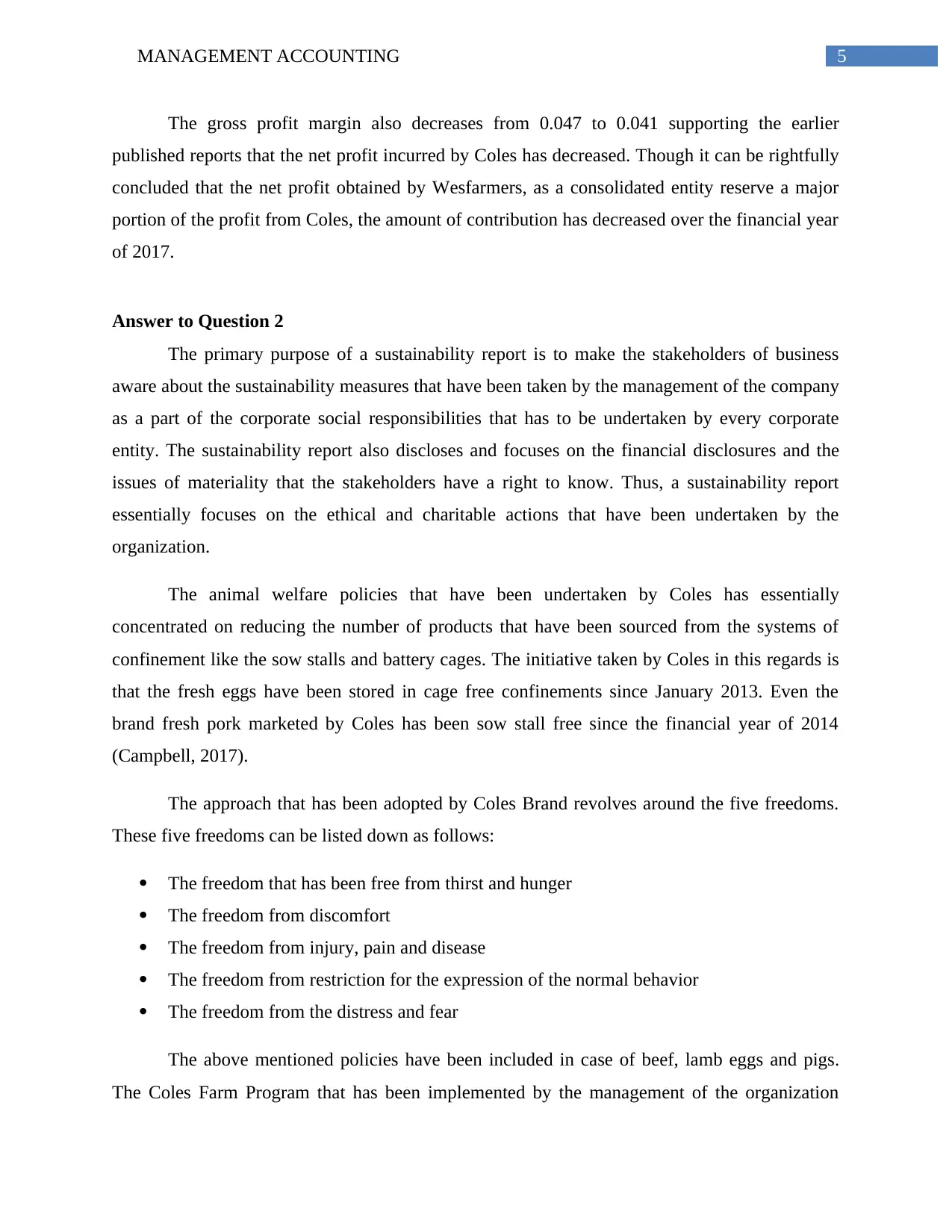
5MANAGEMENT ACCOUNTING
The gross profit margin also decreases from 0.047 to 0.041 supporting the earlier
published reports that the net profit incurred by Coles has decreased. Though it can be rightfully
concluded that the net profit obtained by Wesfarmers, as a consolidated entity reserve a major
portion of the profit from Coles, the amount of contribution has decreased over the financial year
of 2017.
Answer to Question 2
The primary purpose of a sustainability report is to make the stakeholders of business
aware about the sustainability measures that have been taken by the management of the company
as a part of the corporate social responsibilities that has to be undertaken by every corporate
entity. The sustainability report also discloses and focuses on the financial disclosures and the
issues of materiality that the stakeholders have a right to know. Thus, a sustainability report
essentially focuses on the ethical and charitable actions that have been undertaken by the
organization.
The animal welfare policies that have been undertaken by Coles has essentially
concentrated on reducing the number of products that have been sourced from the systems of
confinement like the sow stalls and battery cages. The initiative taken by Coles in this regards is
that the fresh eggs have been stored in cage free confinements since January 2013. Even the
brand fresh pork marketed by Coles has been sow stall free since the financial year of 2014
(Campbell, 2017).
The approach that has been adopted by Coles Brand revolves around the five freedoms.
These five freedoms can be listed down as follows:
The freedom that has been free from thirst and hunger
The freedom from discomfort
The freedom from injury, pain and disease
The freedom from restriction for the expression of the normal behavior
The freedom from the distress and fear
The above mentioned policies have been included in case of beef, lamb eggs and pigs.
The Coles Farm Program that has been implemented by the management of the organization
The gross profit margin also decreases from 0.047 to 0.041 supporting the earlier
published reports that the net profit incurred by Coles has decreased. Though it can be rightfully
concluded that the net profit obtained by Wesfarmers, as a consolidated entity reserve a major
portion of the profit from Coles, the amount of contribution has decreased over the financial year
of 2017.
Answer to Question 2
The primary purpose of a sustainability report is to make the stakeholders of business
aware about the sustainability measures that have been taken by the management of the company
as a part of the corporate social responsibilities that has to be undertaken by every corporate
entity. The sustainability report also discloses and focuses on the financial disclosures and the
issues of materiality that the stakeholders have a right to know. Thus, a sustainability report
essentially focuses on the ethical and charitable actions that have been undertaken by the
organization.
The animal welfare policies that have been undertaken by Coles has essentially
concentrated on reducing the number of products that have been sourced from the systems of
confinement like the sow stalls and battery cages. The initiative taken by Coles in this regards is
that the fresh eggs have been stored in cage free confinements since January 2013. Even the
brand fresh pork marketed by Coles has been sow stall free since the financial year of 2014
(Campbell, 2017).
The approach that has been adopted by Coles Brand revolves around the five freedoms.
These five freedoms can be listed down as follows:
The freedom that has been free from thirst and hunger
The freedom from discomfort
The freedom from injury, pain and disease
The freedom from restriction for the expression of the normal behavior
The freedom from the distress and fear
The above mentioned policies have been included in case of beef, lamb eggs and pigs.
The Coles Farm Program that has been implemented by the management of the organization
⊘ This is a preview!⊘
Do you want full access?
Subscribe today to unlock all pages.

Trusted by 1+ million students worldwide

6MANAGEMENT ACCOUNTING
assesses and consistently provides the monitoring and the maintenance of the animal welfare
standards. Coles has also published in its sustainability report that less than five percent of the
Australian chicken production had been approved by RSPCA (Hussey & Ong, 2017).
The particular recommendation in case of the sustainability report of the company is that
it has in all probabilities, adhered to the good animal husbandry principles:
Maintenance of a particular level of nutrition for sustaining welfare and good health
Accessing the sufficient availability of water that is of premium quality for meeting up to
the physiological needs (Nurhayati, Taylor & Tower, 2016)
Accessing enough space for stretching of limbs by the animals and maintaining their
normal behavior (Zentes, Morschett & Schramm-Klein, 2017)
Minimizing or mitigating the risk of predation
Monitoring that the behavioral and physiological response by an animal in regards to a
painful stimulus should be judged to be reasonable
Identification of the weak or injured cattle and adoption of the appropriate technique
Adequate knowledge about the patters of diseases that are prevalent in the local region
and taking required steps for the prevention of the diseases
Thus, the adherence to the above mentioned principles have made the sustainability report of
Wesfarmers in regards to the farm animal welfare accurate and to the point. There have been
several other principles that the firm can follow. However, given the current instance,
Wesfarmers have been doing a commendable job in regards to producing a sustainable report of
improved quality.
assesses and consistently provides the monitoring and the maintenance of the animal welfare
standards. Coles has also published in its sustainability report that less than five percent of the
Australian chicken production had been approved by RSPCA (Hussey & Ong, 2017).
The particular recommendation in case of the sustainability report of the company is that
it has in all probabilities, adhered to the good animal husbandry principles:
Maintenance of a particular level of nutrition for sustaining welfare and good health
Accessing the sufficient availability of water that is of premium quality for meeting up to
the physiological needs (Nurhayati, Taylor & Tower, 2016)
Accessing enough space for stretching of limbs by the animals and maintaining their
normal behavior (Zentes, Morschett & Schramm-Klein, 2017)
Minimizing or mitigating the risk of predation
Monitoring that the behavioral and physiological response by an animal in regards to a
painful stimulus should be judged to be reasonable
Identification of the weak or injured cattle and adoption of the appropriate technique
Adequate knowledge about the patters of diseases that are prevalent in the local region
and taking required steps for the prevention of the diseases
Thus, the adherence to the above mentioned principles have made the sustainability report of
Wesfarmers in regards to the farm animal welfare accurate and to the point. There have been
several other principles that the firm can follow. However, given the current instance,
Wesfarmers have been doing a commendable job in regards to producing a sustainable report of
improved quality.
Paraphrase This Document
Need a fresh take? Get an instant paraphrase of this document with our AI Paraphraser
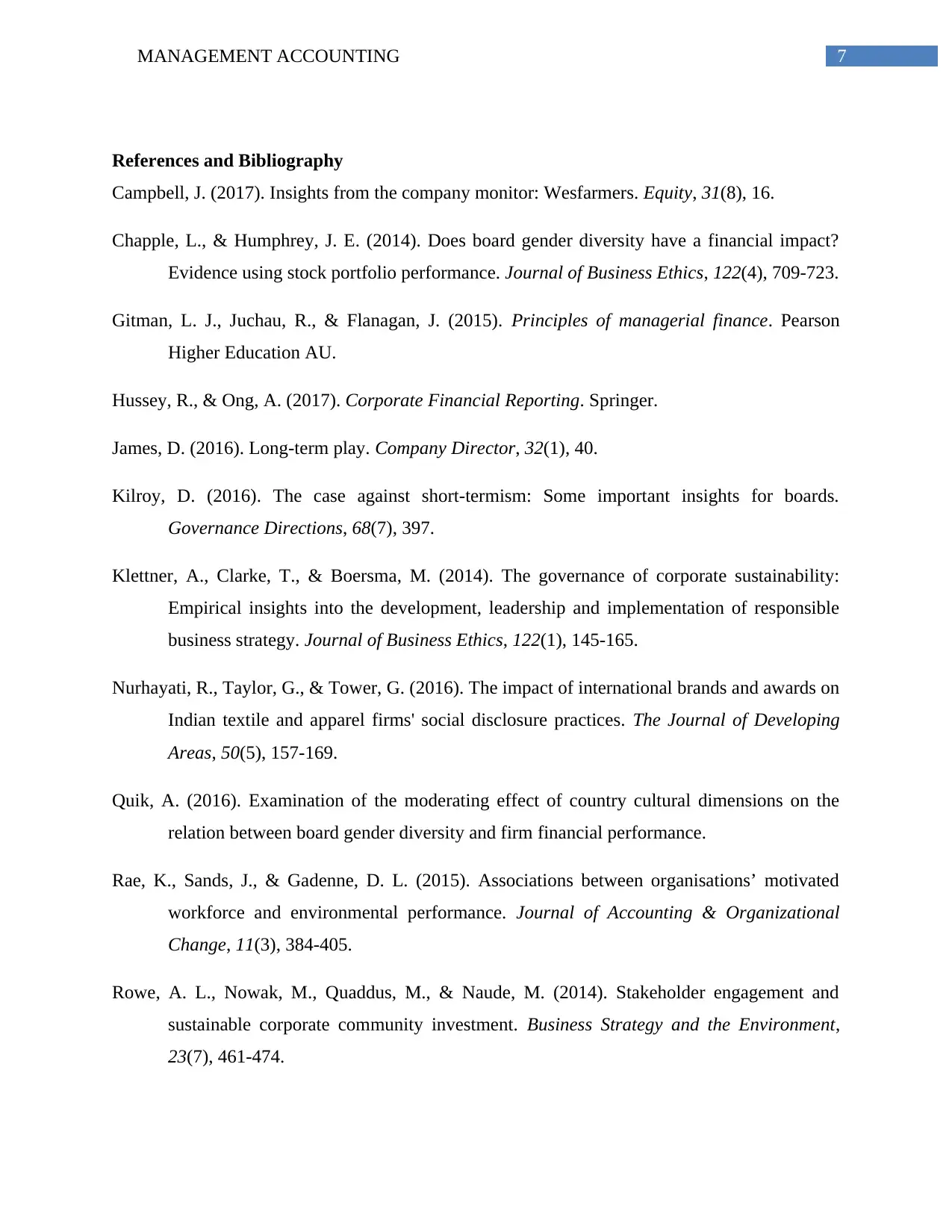
7MANAGEMENT ACCOUNTING
References and Bibliography
Campbell, J. (2017). Insights from the company monitor: Wesfarmers. Equity, 31(8), 16.
Chapple, L., & Humphrey, J. E. (2014). Does board gender diversity have a financial impact?
Evidence using stock portfolio performance. Journal of Business Ethics, 122(4), 709-723.
Gitman, L. J., Juchau, R., & Flanagan, J. (2015). Principles of managerial finance. Pearson
Higher Education AU.
Hussey, R., & Ong, A. (2017). Corporate Financial Reporting. Springer.
James, D. (2016). Long-term play. Company Director, 32(1), 40.
Kilroy, D. (2016). The case against short-termism: Some important insights for boards.
Governance Directions, 68(7), 397.
Klettner, A., Clarke, T., & Boersma, M. (2014). The governance of corporate sustainability:
Empirical insights into the development, leadership and implementation of responsible
business strategy. Journal of Business Ethics, 122(1), 145-165.
Nurhayati, R., Taylor, G., & Tower, G. (2016). The impact of international brands and awards on
Indian textile and apparel firms' social disclosure practices. The Journal of Developing
Areas, 50(5), 157-169.
Quik, A. (2016). Examination of the moderating effect of country cultural dimensions on the
relation between board gender diversity and firm financial performance.
Rae, K., Sands, J., & Gadenne, D. L. (2015). Associations between organisations’ motivated
workforce and environmental performance. Journal of Accounting & Organizational
Change, 11(3), 384-405.
Rowe, A. L., Nowak, M., Quaddus, M., & Naude, M. (2014). Stakeholder engagement and
sustainable corporate community investment. Business Strategy and the Environment,
23(7), 461-474.
References and Bibliography
Campbell, J. (2017). Insights from the company monitor: Wesfarmers. Equity, 31(8), 16.
Chapple, L., & Humphrey, J. E. (2014). Does board gender diversity have a financial impact?
Evidence using stock portfolio performance. Journal of Business Ethics, 122(4), 709-723.
Gitman, L. J., Juchau, R., & Flanagan, J. (2015). Principles of managerial finance. Pearson
Higher Education AU.
Hussey, R., & Ong, A. (2017). Corporate Financial Reporting. Springer.
James, D. (2016). Long-term play. Company Director, 32(1), 40.
Kilroy, D. (2016). The case against short-termism: Some important insights for boards.
Governance Directions, 68(7), 397.
Klettner, A., Clarke, T., & Boersma, M. (2014). The governance of corporate sustainability:
Empirical insights into the development, leadership and implementation of responsible
business strategy. Journal of Business Ethics, 122(1), 145-165.
Nurhayati, R., Taylor, G., & Tower, G. (2016). The impact of international brands and awards on
Indian textile and apparel firms' social disclosure practices. The Journal of Developing
Areas, 50(5), 157-169.
Quik, A. (2016). Examination of the moderating effect of country cultural dimensions on the
relation between board gender diversity and firm financial performance.
Rae, K., Sands, J., & Gadenne, D. L. (2015). Associations between organisations’ motivated
workforce and environmental performance. Journal of Accounting & Organizational
Change, 11(3), 384-405.
Rowe, A. L., Nowak, M., Quaddus, M., & Naude, M. (2014). Stakeholder engagement and
sustainable corporate community investment. Business Strategy and the Environment,
23(7), 461-474.
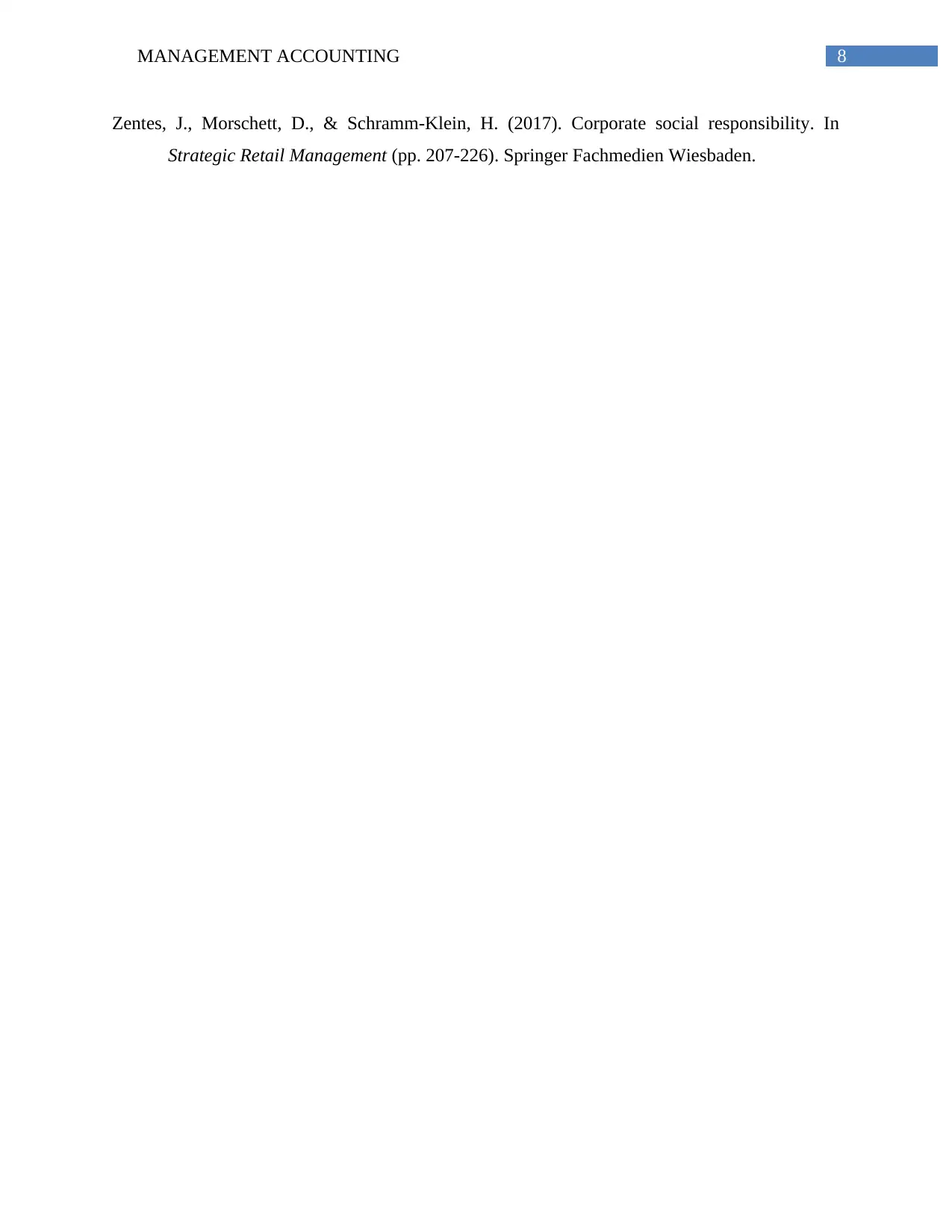
8MANAGEMENT ACCOUNTING
Zentes, J., Morschett, D., & Schramm-Klein, H. (2017). Corporate social responsibility. In
Strategic Retail Management (pp. 207-226). Springer Fachmedien Wiesbaden.
Zentes, J., Morschett, D., & Schramm-Klein, H. (2017). Corporate social responsibility. In
Strategic Retail Management (pp. 207-226). Springer Fachmedien Wiesbaden.
⊘ This is a preview!⊘
Do you want full access?
Subscribe today to unlock all pages.

Trusted by 1+ million students worldwide
1 out of 9
Related Documents
Your All-in-One AI-Powered Toolkit for Academic Success.
+13062052269
info@desklib.com
Available 24*7 on WhatsApp / Email
![[object Object]](/_next/static/media/star-bottom.7253800d.svg)
Unlock your academic potential
Copyright © 2020–2025 A2Z Services. All Rights Reserved. Developed and managed by ZUCOL.





